Game of Thrones Tying the Knot Ceremony

The High Septon conducting the marriage between King Joffrey Baratheon and Lady Margaery Tyrell.
- "These are perilous times. The crown must forge new alliances - and these alliances must often be sealed in matrimony."
- ―Tyrion Lannister [src]
Marriage is a socially, and typically religiously, recognized union between people that establishes legal rights and obligations between them and their children. These often include various inheritance rights for children produced within a marriage to the property, wealth, and titles of their parents. Marriage customs vary across Westeros, Essos, and the rest of the known world.
Contents
- 1 Marriage practices and customs
- 1.1 Political marriage-alliances
- 1.2 Annulment
- 1.3 Maiden names
- 2 Wedding ceremonies and customs
- 2.1 Faith of the Seven
- 2.2 Old Gods of the Forest
- 2.3 Wildlings beyond the Wall
- 2.4 Dothraki
- 2.5 Naathi
- 3 Marriage prohibitions
- 3.1 Celibate organizations
- 3.2 Underage marriage
- 3.3 Same-sex relationships
- 3.4 Incest
- 4 Polygamy
- 5 Bastardy
- 6 Inheritance law
- 7 Prominent marriages
- 7.1 Wed during the TV series in on-screen ceremonies
- 7.2 Wed during the TV series, but off-screen
- 7.3 Wed before the TV series
- 8 In the books
- 9 In real life
- 10 See also
- 11 References
Marriage practices and customs
Political marriage-alliances
The TV series released a behind-the-scenes video featurette about marriage in Westeros (click this link to view), in which George R.R. Martin stressed that as in the real-life Middle Ages, it is by far the norm for the nobility in Westeros to enter into arranged marriages, not for love but to secure political alliances, saying: "Marriage was a way to bind two families together, it was a form of political alliance, and royal marriages are one of the ultimate examples of this."[1]
In noble families, marriages are almost always arranged by the heads of the Houses and often seal political alliances. Marriage makes both noble families kin, binding them together, and thus obligates them to provide military aid to each other in case of conflicts with other noble families.
Historically, some marriages signaled the political union of two previously independent kingdoms - such as when House Targaryen and House Martell intermarried to unite Dorne with the rest of the Seven Kingdoms, a hundred years before the War of the Five Kings. It is also common for a victorious conqueror to marry a daughter from the royal line of a defeated kingdom to solidify his claim to its lands. When House Stark defeated the last Marsh King in ancient times, the King in the North married a daughter of the Marsh King to secure rule over his lands in the Neck. Such marriages also frequently occurred during the Andal Invasion 6,000 years ago: House Lannister, House Tyrell, House Tully, and many other major Houses actually originated during the time of the First Men, but intermarried with the Andal invaders by offering up their daughters in political marriages. A more recent example is during the Targaryen Conquest, when Orys Baratheon married the daughter of the last Storm King from House Durrandon, to solidify his claim over the Stormlands.
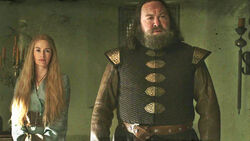
The marriage between King Robert and Queen Cersei wasn't made for love, but to secure a political alliance, which is typical among the nobility in Westeros.
- Robert Baratheon: "Backstabbing doesn't prepare you for a fight and that's all the realm is now: backstabbing and scheming and arse-licking and money-grubbing. Sometimes I don't know what holds it all together."
- Cersei Lannister: "Our marriage?"
- — Robert Baratheon and Cersei Lannister[src]
Most members of the Great Houses of Westeros during the timeframe of the narrative entered into arranged marriages: Catelyn Tully and Eddard Stark, Lysa Tully and Jon Arryn, Robert Baratheon and Cersei Lannister, Stannis Baratheon and Selyse Florent, and during the narrative Margaery Tyrell and her successive husbands (Renly Baratheon, Joffrey Baratheon, and Tommen Baratheon). Sometimes with great work and effort over many years, arranged marriages turn into strong relationships - Catelyn herself championed this aspect of her marriage to Ned when trying to urge her son Robb to enter into an arranged marriage. While they may not grow to love each other, couples in arranged marriages are often able to maintain at least a functional public partnership. Many dread being trapped in miserable arranged marriages, such as Robert and Cersei, or Lysa's loveless marriage to Jon, a good man but old enough to be her father.
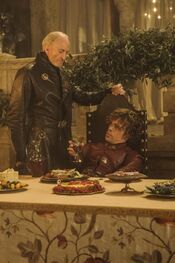
Tywin Lannister married out of love to his first cousin Joanna but hypocritically tried to force his own children into arranged marriages.
Only two major political leaders in Westeros in the current generation married for love: Tywin Lannister and Doran Martell.
Tywin married his own first cousin Joanna Lannister out of love, even though she brought him no new lands or allies. He actually loved Joanna dearly and it was said she brought out the best in him, and her death giving birth to Tyrion left him heartbroken and embittered. Later in life, Tywin hypocritically tried to force all three of his children into loveless arranged marriages, succeeding with Cersei and Tyrion. Doran Martell is another lord who married for love, but as happens in real life, he and his wife eventually fell out of love. In the novels, he wed the noblewoman Mellario of Norvos, but after several years she found the customs of Dorne to be so foreign that she became estranged from Doran and moved back to Norvos (divorce does not exist in Westeros), leaving Doran with a heavy heart.
Brynden Tully, Catelyn's uncle, infamously refused to enter into an arranged marriage his brother set up for him with Bethany Redwyne - despite the fact that all agreed it was a great match, as she was beautiful, wealthy, and it would gain strong allies for the Tullys. Brynden quarreled often with his brother about this over the years and became known as "the Blackfish" as a result. It is not unusual for lords who are privately homosexual to still marry women, such as Renly Baratheon, purely to secure a political alliance and produce heirs ("love" is not generally a major reason for marriage among the nobility in Westeros).
Annulment
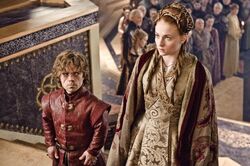
Divorce doesn't exist in the Faith of the Seven, but Sansa's marriage to Tyrion can be annulled upon request - it was obviously forced against her will, and Tyrion never consummated it.
"Divorce" does not exist in Westeros, though annulment does. An annulment can be requested from the hierarchy of the Faith of the Seven due to several factors, such as if the marriage was never consummated (the couple never had sex), if it is later discovered that one of the two was already married (bigamous marriage is forbidden), or if it is argued that the marriage was made under duress, because officially no one can be forced to take a holy vow against their will.
In practice, the daughters of noble Houses are often pressured by their families to marry against their will, but forcibly marrying a woman held hostage against her family's wishes is generally seen as grounds for annulment. For example, Sansa was obviously a prisoner of the Lannisters when she was forced to marry Tyrion, against both her will and that of her entire family, and the marriage was never consummated, so Sansa could theoretically request an annulment from the Faith (she never did that in the show).
It is unknown on what grounds Tywin had Tyrion's first marriage to Tysha annulled, but it can be assumed that Tywin wouldn't let minor technicalities stand in his way, and whoever performed the annulment wouldn't risk Tywin's wrath.
- In the novels, Tywin apparently had the marriage annulled on the grounds that he claimed Tysha was a prostitute who made the vows under false pretenses. However, when Jaime aids Tyrion's escape from the dungeons, he reveals to him the shocking secret that Tysha was not a whore, and Tywin forced her to say she was as the ultimate torment against his hated dwarf son - Tyrion is so enraged on finding this out that it is the primary reason he confronts and kills his father, demanding to know what happened to Tysha. Given that Tysha was not a whore but actually meant her holy vows, from a technical standpoint she and Tyrion would still be considered married, even after all of these years. This would provide more grounds to annul his marriage with Sansa, as they were bigamously married.
- In the episode "High Sparrow", Littlefinger claims that "Tyrion never consummated the marriage. By the law of the land, she's no man's wife." In the novels, it is not that simple: in A Storm of Swords Tywin tells Tyrion, "Do I need to remind you that a marriage that has not been consummated can be set aside?", and Tyrion answers, "By the High Septon or a Council of Faith." Hence, marriage can be annulled on the ground of non-consummation, but not automatically - there has to be an official ceremony conducted by the Faith's ruling hierarchy. Tywin doesn't specifically mention other reasons for annulment such as forced marriage, though they may exist as well. Later when Sansa is in the Vale with Littlefinger, and plans to marry her to Sweetrobin's heir Harrold Hardyng, Littlefinger also says that the actual marriage to Harrold will have to wait until after she is widowed (he says nothing about annulment). It is unclear if both husband and wife must be present when requesting an annulment, or if one is sufficient.
- In the novels, Ramsay Bolton married Jeyne Poole, Sansa's best friend at Winterfell, taken captive and passed off as Arya Stark. The Boltons knew she wasn't really Arya but with both Stark girls missing, the Lannisters and Boltons agreed to just publicly pretend she was really Arya to establish a token claim to Winterfell. The TV series drastically condensed this by having Ramsay Bolton actually marry the real Sansa Stark (Sansa never even meets the Boltons in the books). Even in this situation, while Sansa's marriage to Tyrion could be annulled upon request it hadn't been annulled yet when she married Ramsay - making her marriage to Ramsay technically bigamous (even if her marriage to Tyrion was unconsummated), and thus also subject to annulment if it is later requested.
While going through some records at the Citadel, Gilly makes a shocking discovery that Rhaegar Targaryen had his marriage to his lawful wife Elia Martell annulled by the High Septon and remarried in Dorne.[2]
- This might be an extreme over-simplification by the TV series, as in the novels it seems more probable that Rhaegar intended to polygamously marry Lyanna as his second wife, in the custom of his Valyrian ancestors and the early Targaryen kings. For further analysis, see: "Rhaegar_Targaryen#Rhaegar's annulment from Elia Martell in the TV series"
It is unknown have annulment and/or divorce function under other religions, specifically the Old Gods in the North and the Drowned God religion of the Iron Islands (or if any world religions even have voluntary "divorce" in them). The religion of the Old Gods doesn't even have a formal priesthood to ask permission from.
- In an analysis video on annulment under the Faith of the Seven, Elio Garcia and Linda Antonsson of Westeros.org - co-authors of the World of Ice and Fire sourcebook with Martin - could only make the stray speculation that they assumed if a Northman who followed the Old Gods wanted to annul his wife, he would probably just announce "You are no longer my wife" to her in front of public witnesses.[3] They made no attempt to speculate on what legal grounds this could be made on i.e. if they would be different from the Faith of the Seven's strict standards of non-consummation or bigamy, or if they can be made at will - or if this would render any children they had illegitimate. The ironborn, meanwhile, practice a limited form of polygamy (with one primary wife and multiple secondary ones), so it is unknown if this is an issue that ever comes up for them, rarely if at all.
Maiden names
Women from noble Houses in Westeros often take on their husband's surname - though this is not automatic and many do not. Essentially, if a noblewoman "marries up" into a more powerful noble family, she will tend to shift to using the name of her husband's House. Conversely, if a noblewoman marries into a less powerful noble House (i.e., if she is one of the younger daughters in the family, not able to secure as good of a match) then she will often retain the use of her original family name, to remind everyone of her social and political ties. If their two families are of roughly equal power - such as if they are both from Great Houses that rule entire kingdoms - then the situation is more variable, and is more dependent on personal choice.
Only the nobility in Westeros even use surnames - the smallfolk do not have last names at all.
A primary example is Cersei Lannister - rarely if ever called "Cersei Baratheon", despite marrying King Robert Baratheon. She apparently kept using her maiden name to remind everyone around her at the royal court that her own family (specifically her father Tywin) were the main financial supporters of Robert's reign, and he was dependent on them. Similarly, Margaery Tyrell is rarely called "Margaery Baratheon" even though she married three men named "Baratheon" in succession: Renly, then Renly's (alleged) nephew Joffrey, then Joffrey's younger brother Tommen. When Margaery was first introduced in Season 2, she had already married Renly off-screen, yet she was still pervasively referred to as "Margaery Tyrell" - even after her third marriage to Tommen Baratheon, the only one that was actually consummated. This is because Tommen and the Lannisters are now dependent on the financial support of House Tyrell, just as the Baratheons were once dependent on the Lannisters. Before Robert's Rebellion, Elia Martell was the wife of Crown Prince Rhaegar Targaryen and the mother of his children, but she was still uniformly referred to as "Elia Martell" - though while Elia technically married up into the royal line, the Martells only entered the realm through peaceful marriage-alliance, styling their rules as "Princes" instead of Lords. Therefore it seems possible that the Martells considered themselves equal to the Targaryens, not a lowly vassal House marrying up into the royal family.
Other times this can be more fluid: Catelyn Stark was born "Catelyn Tully", yet both House Tully and House Stark are Great Houses. The Starks were considered to be a more powerful and prestigious House than the Tullys (the Stark dynasty were kings in ancient times, while the Tullys never ruled as kings), plus Catelyn came to greatly love her husband Eddard Stark, so perhaps this was simply out of deference to him. Either way, she is still often referred to as "Catelyn Stark" or "Catelyn Tully" interchangeably. In contrast, her younger sister Lysa also married into another Great House when she wed Jon Arryn, and in the present day Lysa is pervasively known as "Lysa Arryn" - so perhaps it had more to do with the fact that the Tullys, while a Great House, weren't considered as prestigious (the Arryns were also kings once). Alternatively it really might just have been down to personal preference.
Children usually take the name of their father's House, regardless of whether their mother continues to be known by her maiden name or not. This is probably due to the male-preference primogeniture laws in most of the Seven Kingdoms. Dorne, however, is apparently an exception, given that unique among the rest it follows gender-blind primogeniture laws. Doran Martell is the current Prince of Dorne, but he inherited the title from his mother, who herself inherited rule from her own parents. Doran, Oberyn, and Elia therefore used their mother's surname, apparently because it was more prestigious. It is unclear if this would happen in the rest of Westeros (i.e., in the novels, Tywin's younger sister Genna Lannister married a younger son of House Frey, long before they took over from the Tullys, yet their children all used the surname "Frey", not "Lannister").
- In the novels, Sansa Stark is never renamed as "Sansa Lannister" after marrying Tyrion Lannister. The TV series itself only referred to this once, when at the beginning of Season 4 Tyrion's brother Jaime sarcastically pointed out that she was "Sansa Lannister" now and there was little he could do about it. Even in the TV series this does not reflect a pervasive pattern of usage (if anything Tyrion would want to emphasize Sansa's status as a Stark so he could rule the North through her). The third novel was split across Seasons 3 and 4, so that Sansa married Tyrion but then fled King's Landing all within the same book. As a result, the appendices at the end of book three and book four continue to list her as "Sansa Stark", not "Sansa Lannister": both she and Tyrion considered it a sham marriage forced upon each of them, and not real because they never consummated it. Further, while Sansa never married Ramsay Bolton in the novels, she wouldn't automatically start being called "Sansa Bolton" if she did (as in the TV series) because women often keep using their maiden name if it is prestigious (the Boltons also want to emphasize that she is Sansa "Stark" and thus gives them a claim to Winterfell).
Wedding ceremonies and customs
The wedding ceremonies that mark the beginning of a marriage vary between different religions and cultures.
Faith of the Seven
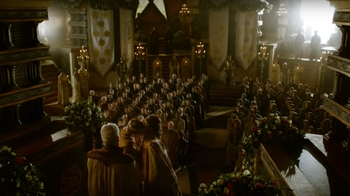
The royal wedding in the Great Sept of Baelor between King Joffrey Baratheon and Margaery Tyrell, conducted by the High Septon - a very extravagant example of a wedding ceremony in the Faith of the Seven.
The Faith of the Seven has large wedding ceremonies filled with numerous prayers, customs, and vows. The ceremony is officiated by a septon, one of the male priests of the Faith (it is unclear if septas, female priests, can also officiate at weddings). Wedding ceremonies are typically held within a sept, the religious structures of the Faith. Septs are seven-sided buildings, with statues or icons of each of the Seven along each wall: weddings are conducted with the bride, groom, and septon standing between the statues of the Father and the Mother. The members of both families and guests form an audience to witness the ceremony, separated by an aisle in the middle (typically, the bride's family on the left side behind her, and the groom's family on the right side behind him). The audience and the couple face forward towards the space between the two statues, while the septon faces the audience and the couple.
There are several other events before the main ceremony, which usually occurs around mid-day and is followed by a feast lasting into the night. Sometimes a wedding breakfast is held at which gifts are presented to the bride and groom. This wedding breakfast was seen at the wedding of Margaery and Joffrey but not the wedding of Edmure and Roslin. The novels actually mention that it is specifically a local custom in the Reach, the region ruled by House Tyrell, to hold a wedding breakfast at which gifts are presented, before the main ceremony, which might explain why this wasn't seen with Edmure Tully and Roslin Frey (who are from the Riverlands). Each of the Seven Kingdoms may in fact have its own local wedding customs that are slightly different from each other. The novels also explain that there are two wedding breakfasts held separately: one is attended only by the bride and the women of her family, the other by the groom's entire family (men and women) and men from the bride's family. This explains why, in the TV version, when Joffrey is presented with gifts at his wedding breakfast, Margaery and Olenna Tyrell are not present (though Joffrey's mother Cersei and Margaery's father Mace Tyrell are present).
The full wedding ceremony in the Faith of the Seven is a long event filled with many prayers and vows; it is quite long compared to the simple exchange of vows in the wedding ceremonies of those who follow the Old Gods of the Forest. As a result, the TV series has never shown a single wedding ceremony from start to finish, but has skipped around in time for several wedding scenes to show several different key points from the ceremony, i.e., some of the vows said in the wedding scene between Margaery Tyrell and Joffrey Baratheon are skipped in the subsequent wedding between Margaery Tyrell and Tommen Baratheon. The full wedding ceremony might last over an hour, but the TV series only has time to show about two to three minutes' worth of clips from each one.
As of the end of Season 5, the TV series has presented five wedding ceremonies from the Faith of the Seven:
- Tyrion Lannister and Sansa Stark (episode 3.8 "Second Sons")
- Edmure Tully and Roslin Frey (episode 3.9 "The Rains of Castamere")
- Margaery Tyrell and Joffrey Baratheon (episode 4.2 "The Lion and the Rose")
- Margaery Tyrell and Tommen Baratheon (episode 5.3, "High Sparrow")
- The small, secret wedding ceremony between Robb Stark and Talisa (episode 2.10 "Valar Morghulis").
The Tyrion/Sansa wedding was only shown up to the point that the groom cloaked the bride before the camera cut away. Only a brief excerpt from the Margaery/Tommen wedding was shown on-camera, the point when the couple recites their vows. The Robb/Talisa wedding was a small private ceremony held in secret, and thus in-universe didn't include many steps.
Piecing together different points from different wedding ceremonies seen in the TV series, a general description of what the full wedding ceremony is like can be compiled:
First, the officiating septon recites several prayers to the audience, including readings from their holy text, The Seven-Pointed Star. During these initial prayers, the groom waits with the septon between the statues, while the bride waits outside of the room.
- This step takes some time and has never appeared directly on screen. It can be inferred from the prop books made for the septons in some of these scenes, which contain longer sets of prayers leading up to the part where the couple exchanges vows.
Next, the bride is ceremonially presented to the groom, by being led into the room and down the aisle to him. The bride is typically led and presented by her father. In all observed cases, they walk down the aisle side by side, taking each other by the arm, with the father on the right and the bride on the left - then after being presented the couple stands in front of the septon with the bride still on the left and now the groom and the right. If the bride's father is dead, her brothers or other close male family member often lead her down the aisle instead (it is unclear what happens if a bride has no close male relatives and the current head of her family is her mother, etc.) After walking down the aisle, the father silently presents the bride to the groom - without exchanging any dialogue (unlike the wedding ceremony for the Old Gods of the Forest). Sometimes the bride wears a veil which is pulled back when her father presents her to the groom (Roslin Frey), but many brides simply forego wearing a veil (Tyrion and Sansa, Margaery and Joffrey, Margaery and Tommen). It is traditional for the bride to wear an ivory or white gown[4] (apparently to symbolize her purity/virginity), but many brides will forego this for more elaborate designs (e.g., Sansa was a virgin, and had a generally cream-colored gown, but decorated with elaborate colored embroidery).

Margaery Tyrell is walked down the aisle and given away by her father, Mace Tyrell.
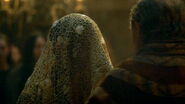
Roslin Frey wears a veil when she is walked down the aisle, which her father pulls back when he presents her to the groom (many other brides choose not to have a veil).

At the Tyrion/Sansa wedding, the audience forms an aisle leading from the entrance between the statues of the Stranger and the Crone.

At the Margaery/Joffrey wedding, however, the audience forms even columns with the end pointing directly at the statue of the Stranger.
- During the Sansa/Tyrion wedding in Season 2, the audience forms an aisle that slants at an angle for the bride to walk down from the entryway between the statues of the Stranger and the Crone to where the groom and septon are waiting, between the statues of the Mother and the Father. Because there are an odd number of gods, the point in the room immediately opposite the statues of the Mother and Father is actually the statue of the Stranger - the two main entrances flank the Stranger's statue. The other entrance is located between the Stranger and the Smith - it isn't clear why they use one and not the other, perhaps because the Crone represents the future, i.e., the couple's future married life together. At any rate, every other wedding does not do this - even the Margaery/Joffrey and Margaery/Tommen weddings in Season 4 and 5, which were also held in the Great Sept of Baelor. At these other weddings the audience just forms two even columns relative to the statues of the Mother and Father. Other septs such as at the Edmure/Roslin wedding don't have prominent statues, so the audience also makes two even columns relative to the altar. It is possible that this simply happened because each of these weddings were in different episodes, with different directors.
Now that the couple are together, the ceremony between them and the septon begins in earnest. The septon tells the groom, "You may now cloak the bride and bring her under your protection." The groom takes off the initial cloak that the bride has around her shoulders, displaying the sigil of her noble House, and puts a new cloak around her shoulders, bearing the sigil of the groom's House - symbolically bringing her under his protection and into his family. In some weddings the bride doesn't start out with her own cloak, but all include the step of the groom putting a cloak around her.
- This step is shown at the Tyrion/Sansa, Edmure/Roslin, and Margaery/Joffrey weddings. The septon wasn't shown speaking the instruction at the Margaery/Joffrey wedding, though Joffrey is shown cloaking Margaery - but the septons do say the line at the other two weddings. In the novels, it is specified that for the Margaery/Joffrey wedding, Cersei's wedding gift to Margaery was the same purpose-made wedding cloak that her own mother Joanna Lannister used at her own wedding to Tywin.
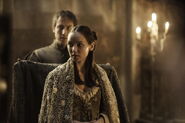
Edmure ready to wrap his cloak around Roslin's shoulders
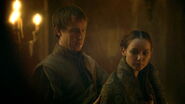
Roslin now wrapped in Edmure's cloak
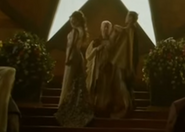
Joffrey takes off his cloak and gets ready to put it on Margaery
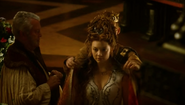
Joffrey wrapping his cloak around Margaery
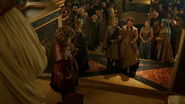
Joffrey presents Sansa to the groom because her father is dead, claiming he can stand in for him because he is king; note that Tyrion is holding a cloak.
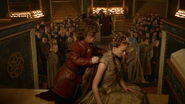
Tyrion tries to wrap his cloak around Sansa, but due to his short height she has to stoop so he can reach.
The septon then proclaims, "My lords, my ladies, we stand here in the sight of gods and men to witness the union of man and wife. One flesh, one heart, one soul, now and forever."
- This step is only shown at the Tyrion/Sansa wedding.
The couple holds hands as they stand side by side. The septon proceeds to tie a ribbon in a knot around their joined hands (literally "tying the knot"), which symbolizes their union. While tying the ribbon the septon says, "Let it be known that [Names and Houses of the bride and groom] are one heart, one flesh, one soul. Cursed be he who would seek to tear them asunder." The septon then announces, "In the sight of the Seven, I hereby seal these two souls, binding them as one for eternity." After he says this he unravels the ribbon - they remain metaphorically joined for the rest of their lives.
- This step with the ribbon was shown at the Edmure/Roslin and Margaery/Joffrey weddings, and also the secret Robb/Talisa wedding. The camera cut away from the Tyrion/Sansa wedding before this point. The septon only said the first line at the Joffrey/Margaery wedding: "Let it be known that Margaery of House Tyrell and Joffrey of the Houses Lannister and Baratheon are one heart..." etc., without using the second line. The Edmure/Roslin and Robb/Talisa weddings, however, only have the septon give the second line. It is unclear if both lines are from a longer, unaired version of the ceremony, or if these are actually variant invocations in-universe.
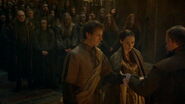
Edmure and Roslin join hands, which the septon begins wrapping a ribbon around.
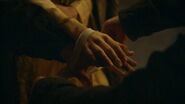
The septon "ties the knot" around Edmure and Roslin's hands while reciting the prayers.
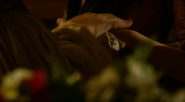
Margaery and Joffrey's hands tied together with a ribbon, as the High Septon prays over them.
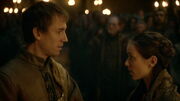
Edmure and Roslin recite their vows, ending with "...from this day, until the end of my days."
The septon them commands, "Look upon each other and say the words", at which the bride and groom recite their vows, both of them speaking simultaneously. First, they list off the names of each of the Seven, in whose sight they are wedding: "Father, Smith, Warrior, Mother, Maiden, Crone, Stranger..." Immediately following this, still speaking simultaneously, they recite their main vows: the groom says "I am hers and she is mine. From this day, until the end of my days," while the bride at the same time says "I am his and he is mine. From this day, until the end of my days."
- This full step, reciting the names of the Seven, then saying "I am his and she is mine" (and the reverse) is shown for the Edmure/Roslin wedding, and the Robb/Talisa secret ceremony. The Margaery/Tommen wedding is very brief and in fact the only part of the entire wedding shown is when they recite "I am his and she is mine", the camera cutting in right at that moment and skipping the naming of the Seven. The Margaery/Joffrey wedding scene entirely skips over showing this step on-camera.
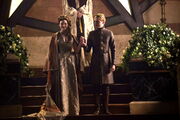
Having exchanged their vows and kissed, the now-married Tommen Baratheon and Margaery Tyrell turn to face the audience and receive their applause.
This last line is the central vow of the ceremony, to the point that unwed lovers are known to playfully quote it by telling each other "I am yours and you are mine, from this day until the end of my days" (or variants thereof) as an expression of love. Joffrey said this to Sansa in Season 1's "A Golden Crown" when he was briefly trying to be kind to her, and gave her a Lannister lion necklace (though it wasn't clear to the audience at the time he was quoting a phrase from marriage vows), while Tyrion and Shae said it to each other in Season 2.
Finally, after the vows are finished, the groom announces, "With this kiss, I pledge my love," and kisses the bride for the first time. They both then turn to face the audience, who applaud.
- The groom is only shown making the proclamation at the Margaery/Joffrey wedding, after which he kisses her and the audience applauds. At the Margaery/Tommen wedding the camera skips from them reciting their vows to kissing, with no proclamation by the groom. The camera cut away from the Tyrion/Sansa and Edmure/Roslin weddings before this point in the ceremony. Robb and Talisa just kiss because their secret wedding doesn't have an audience to address.
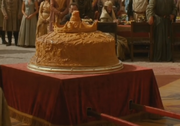
The traditional Pigeon pie at the royal wedding between Joffrey and Margaery.
Following the ceremony, a wedding feast is held for all attendees. Among the nobility these can be quite large and extravagant, particularly for royal weddings. Traditionally a large Pigeon pie is served at the weddings of the nobility (commoners often cannot afford such a large meat pie, or sometimes not at all). The pie is meant to be large enough that every guest can have a slice. It is also traditional for the bride and groom to be the first to cut the cake and taste it.
- Traditional large pigeon pies at weddings in Westeros are essentially analogous to the traditional baked pastry wedding cakes often served at real-life modern weddings.
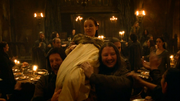
Roslin Frey is carried away from the wedding feast in a bedding ceremony.
After some time, the traditional bedding ceremony may take place, a ribald practice in which the newlyweds are carried to the marriage bed to consummate their marriage by having sex for the first time (after everyone else leaves the room). The feast continues for the guests. The idea behind the bedding custom is that it helps to confirm that the marriage was consummated (it therefore seems to be more common among the nobility, who are more concerned about bloodlines). The bedding custom is not a requirement, however, and sometimes the couple simply skip it, and just quietly leave the feast for their wedding chambers where they will consummate the marriage that night.
Sometimes a couple who wish to marry for love, against their family's wishes, will perform secret weddings. These are still considered lawful so long as they are conducted by a septon and the couple speak their vows, though the ceremony won't be as large or include a big audience. Tyrion Lannister explained in Season 1's "Baelor" that when he was fifteen he eloped with the commoner Tysha when he was a teenager by bribing a drunken septon to marry them in secret (but then the septon sobered up and told his father, then Tywin had his guards gang-rape Tysha, had the marriage annulled, then sent her away and Tyrion never saw her again).
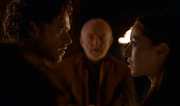
Robb Stark and Talisa secretly marry - in a Faith of the Seven style ceremony conducted by a septon.
Robb Stark secretly marries Talisa in the Season 2 finale, "Valar Morghulis". The circumstances of Robb's marriage are very different in the novels, in which the character he marries is actually named Jeyne Westerling. The Westerlings are minor Lannister vassals but the TV version made "Talisa" a foreigner from Volantis. The showrunners so drastically altered the character that George R.R. Martin felt it wasn't even the same character anymore, and asked Benioff and Weiss to at least acknowledge this by outright renaming the character. At any rate, Robb's wedding ceremony to Jeyne was never actually shown in the novels - though given that the Westerlings seem to follow the Faith of the Seven, it is quite probable that they were married under the rites of the Faith of the Seven by the castle's septon.

In the TV version, a septon ties a knot of ribbon around Robb and Talisa's hands, in the name of the Seven - but this is actually how Robb's own parents were married in the novels.
The TV version shows Robb having a Faith of the Seven style wedding ceremony with Talisa - which caused some confusion among viewers, given that Robb seems to closely follow the Old Gods of the Forest like his father Eddard, while if Talisa is now from Volantis, she wouldn't follow a Westerosi religion at all (unlike her book counterpart, Jeyne). Writer Bryan Cogman addressed this in Q&A, however, pointing out that Robb himself came from an interfaith household (his father followed the Old Gods, but his own mother follows the Faith of the Seven), so Robb was comfortable with it, and just liked the pageantry of the ceremony. In fact, Eddard himself married Catelyn in a Faith of the Seven style wedding. The Old Gods wedding ceremony is very simplistic in contrast - nor does the religion have any priests or holy texts. Given that the Old Gods "don't have many rules", there happened to be a septon available and TV-Robb just chose this ceremony for fun, almost on a whim (which is entirely plausible in-context).[5]
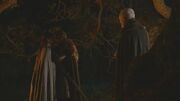
Robb did incorporate some Old Gods wedding elements at his own: held at night, by torchlight, apparently in a godswood. There was no large audience so many steps were removed from the small private ceremony.
Robb and Talisa's secret wedding doesn't have a large audience, so it was apparently a simple version omitting many of the traditional prayers (unless the camera is meant to be skipping parts), but includes the core part at which the septon wraps their hands together with a ribbon to bind them together, then they both recite the names of the Seven, then say "I am his/hers and he/she is mine, from this day, until the end of my days," and then they kiss. Indeed, on closer inspection, it seems as if Robb Stark's wedding is almost a hybrid of the Faith of the Seven and Old Gods wedding ceremonies: it isn't performed in a sept at all, but seems to be held in a local godswood in front of a large tree. Moreover, Faith of the Seven wedding ceremonies are typically held during the day, while Robb and Talisa's wedding is held at night by torchlight - which is actually how Old Gods style wedding ceremonies are conducted.
Old Gods of the Forest

The religion of the Old Gods simply has no clergy, so the wedding ceremony is usually officiated by the father of the groom (Roose).
In the North, where the Old Gods of the Forest still hold sway, there is no clergy in the religion so the wedding ceremony is (apparently) simply officiated by the head of the groom's household (usually his father).
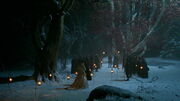
At night, the bride is led to the heart tree at the center of the godswood, with lanterns set up to light the path.
The wedding ceremony is conducted at night in a castle's godswood, before the sacred weirwood heart tree at its center with a face carved into its trunk ages before, so that the ceremony can be witnessed by the Old Gods. The guests carry torches to light the area, and the groom waits before the heart tree with them. The bride is ritualistically led to the group gathered around the heart tree by a member of her family - usually her father or one of her brothers (but it can also be a ward of their family). After leading the bride before the heart tree, he formally presents her to the person officiating the ceremony - overall this is similar to the part of the wedding ceremony in the Faith of the Seven in which a bride's father (or other close relative if her father is dead) leads her into a sept and presents her before the officiating septon at the altar.
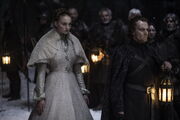
The bride (Sansa) is presented before the godswood's weirwood heart tree.
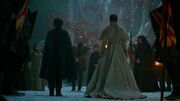
The bride and groom exchange vows before the wedding guests assembled in front of the heart tree.
After the bride is led before the heart tree, several ritualistic lines are exchanged between the officiator and the person presenting the bride. First, the groom's father demands who comes before the Old Gods. The bride's presenter responds that they have come to beg the blessing of the Gods for their marriage, before asking who comes to claim her:
The groom steps forward and announces his claim before asking who gives his bride away. Once the bride's father/presenter has introduced himself, the groom's father asks whether the bride will take his son as a husband.
- Ramsay Bolton: "Ramsay, of House Bolton, heir to the Dreadfort and Winterfell. Who gives her?"
- Theon Greyjoy: "Theon, of the House Greyjoy, who was... who was her father's ward."
- Roose Bolton: "Lady Sansa, do you take this man?"
- — Ramsay claims Sansa and Lord Bolton asks her consent.[src]
The bride then agrees by saying "I take this man", and the wedding is done. The entire ceremony is simpler than the longer wedding ceremony in the Faith of the Seven which involves more steps and the lengthy recitation of various prayers, etc., but the core elements of presenting and "giving away" the bride, and the bride and groom exchanging vows witnessed by the guests and their gods, are essentially similar. As with the Faith of the Seven, after the ceremony at which the vows are exchanged, the wedding party celebrates with a large feast.
Sansa Stark was wed to Ramsay Bolton in such a ceremony. Since her father and brothers were all thought to be dead, Theon Greyjoy, who had been Lord Stark's ward, gave her away while Lord Roose Bolton, Ramsay's father, officiated the ceremony.[6]
- The only wedding ceremony by followers of the Old Gods seen in the novels was that of Ramsay Bolton to Jeyne Poole (pretending to be Arya Stark - changed to actually be Sansa Stark in the TV version). The actual ceremony presented in the TV version matches how the rituals at Ramsay's wedding play out in the novels - but even in the novels it isn't clear how representative this example is of "standard" weddings under the rites of the Old Gods. The Old Gods simply have no clergy, so presumably the father of the groom typically officiates the wedding ceremony (as Roose did for Ramsay), and the bride is given away by her father (and, as with the Faith of the Seven, if her father is dead the next closest male relative, such as her brother - or, a ward raised like a brother, in Theon's case). However, it isn't clear what happens if the groom's mother is the current head of the family (as is currently the case with House Mormont); if the female head of a House is allowed to conduct the ceremony, or if there is some tradition that only the next closest male relative can perform the roles in the ceremony.
- There are actually three slight differences between how the wedding rites are presented in the TV version compared to the novels. First, the full phrase used to introduced the bride is, "A woman grown and flowered, trueborn and noble" - the TV series has used the term "flowering", Westeros's euphemism for menstruating, but infrequently enough that not every viewer might be readily familiar with it, so it was apparently cut for dramatic pacing. Second, in the TV series the bride is asked "do you take this man?", but in the novels the question is actually phrased as "will you take this man?" Third and finally, in the TV version the scene cuts immediately to Ramsay's chambers after his bride says "I take this man", implying (but not outright stating) that this is the end of the ceremony. Actually there is one final, albeit wordless step: after the bride agrees to "take this man", the bride and groom join hands and then kneel before the heart tree so the Old Gods can witness their union. A moment is then spent in silent prayer by the entire wedding party. The bride and groom then rise, and similar to the wedding custom in the Faith of the Seven, the groom takes off the bride's current cloak (bearing the sigil of the House she was born into) and wraps a new cloak around her shoulders (bearing the sigil of the groom's House). No lines are spoken during any of this, by the couple or the officiator, after the bride says "I take this man" through when the groom silently puts the new cloak around her shoulders. At this point the wedding is finished. This step probably still exists in the TV continuity, the camera just immediately cut away without showing it (it's possible they avoided it because the scene was filmed in multiple takes, and kneeling in fake snow would have noticeably marred the actress's wedding gown). Even within the books' narrative, Theon thinks to himself how simple and fast weddings in the Old Gods religion are compared to other religions: "Quick as that, it was done. Weddings went more quickly in the north. It came of not having priests, Theon supposed."
- The novels specify that due to the interfaith marriage of Eddard Stark and Catelyn Tully, they were married in the sept at Riverrun in a Faith of the Seven style wedding ceremony, not an Old Gods style wedding. It was a double ceremony at which Catelyn's younger sister Lysa Tully was also married, to Eddard's great friend and mentor Jon Arryn. The weddings were conducted in relative haste to secure political alliances between their families due to the outbreak of Robert's Rebellion. Afterwards Eddard rode south to war, but he had already managed to impregnate Catelyn with their first son Robb before he left.
Wildlings beyond the Wall
- "If a man wants a woman, he has to prove he'll give her strong and cunning sons. It's easy: when she tries to slit his throat, he don't let her."
- ―Ygritte explains marriage customs among the wildlings. [src]
The Free Folk clans that live beyond the Wall (called "wildlings" by the inhabitants of the Seven Kingdoms) also follow the religion of the Old Gods of the Forest like their Northmen cousins do (as both descend from the First Men). Wildling social customs, however, are apparently much simpler - given that they don't have a hereditary system of inheritance necessitating political marriages between different aristocratic dynasties.

Having captured a woman, a wildling man prevents her attempt to kill him with a dagger: as a result, they are "married".
As Ygritte explains in a Histories & Lore animated featurette,[7] wildling men often take brides by ritualistically (or not-so-ritualistically) kidnapping them from their village. The "bride" can and often will try to slit his throat, and if he prevents her from succeeding, quite simply they are considered "married". Wildling women - many of whom are spearwives capable of holding their own in combat - want a husband who is strong, quick, and cunning. Thus if a man manages to capture her and overpower her attempts to kill him, he has proven that he is worthy and earns her respect.
- It isn't clear in the novels if all of the wildlings "marry" through wife-stealing (which is usually a ritualized event, but sometimes isn't), or if at least some of them follow the fairly simple ritual in front of a heart tree as seen in the description of Ramsay Bolton's Northmen-style wedding at Winterfell's godswood - and wife-stealing is their version of a simpler "common-law marriage" of a sort.
- It is possible that none of them follow the Northmen-style wedding ceremony, given that they don't have a social structure based around noble Houses and securing hereditary inheritance through bloodlines - in which case they don't really have a need to formally "give away" daughters in marriage from one dynasty to another. The wildlings are very diverse and may have different local customs from one clan to the next. Whatever the case, ritualized wife-stealing is very common, given the overall attitude that beyond the Wall there are no formal "laws", and if someone can simply keep and hold something, that means it is theirs. Thus if a man and woman choose to cohabitate together and can fight off anyone who attempts to take their hut from them, they can call themselves "married" and no one can tell them otherwise. Among the Northmen, because their religion has no clergy, the "head of the noble House" conducts the ceremony, but a wildling acknowledges the authority of no man over him (only following leaders he chooses to follow freely), which essentially makes each man the head of his own "household", and capable of just declaring himself married to a woman.

Given that Jon Snow managed to capture Ygritte, and later had sex with her, they could technically be considered "married" in wildling culture.
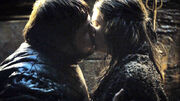
Similarly, when they had sex in the novels, Gilly exclaimed that she is Samwell's "wife" now.
- In the novels, it is later explained in more detail to Jon Snow that because he managed to successfully capture Ygritte and later have sex with her, and because they don't have formal "laws" so much as loose customs when it comes to marriage, this is enough for the wildlings to consider them married, without any ceremony - and for Ygritte to call herself Jon's wife (bluntly, "Jon's woman"). Essentially if a man has sex with a woman and she voluntarily stays in a relationship with him, it is enough to be considered "husband and wife" in wildling culture. Similarly, Gilly could be considered to be Samwell Tarly's wife under wildling customs. When Gilly has sex with Sam in the novels, she whispers "I am your wife now" to him - though they had sex when they were both very drunk and upset after Maester Aemon died, and later after they sobered up and regained control they were both quite embarrassed about it. Gilly doesn't call herself Sam's "wife" afterwards, and he is reluctant to have sex with her again due to his vows. Sam didn't "kidnap" or capture Gilly, however, though he could be said to have "absconded" with her from Craster's Keep.
Dothraki
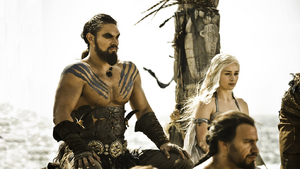
Khal Drogo and Daenerys Targaryen at their Dothraki wedding feast in Pentos.
The traditional Dothraki wedding ceremony is a daylong feast in which gifts are presented to the new couple. Displays of personal combat, duels to the death, and wild public orgies are commonplace at such feasts. A Dothraki wedding without at least three deaths is considered a dull affair.
The wedding feast lasts from dawn to sunset, at which time the new husband and wife consummate their marriage. Because the Dothraki spend most of their time riding on the open plains, everything of importance in Dothraki culture is done outdoors under the sky. Thus, on their wedding night, a Dothraki couple rides away from the main camp to the open plains, and consummate their marriage under the stars.[8]
It isn't clear if any further ceremony or religious invocations are made at a Dothraki wedding, as no priests seem to be present. However, after marrying a khal is expected to return back to the Dothraki holy city Vaes Dothrak to present his new bride to the dosh khaleen, the council of widows of past khals who essentially form the only "priesthood" that the Dothraki have, interpreting favorable omens from the Great Stallion that is the central deity of their religion.[9]
- In the novels, another Dothraki wedding custom is described at Daenerys's wedding feast to Khal Drogo, in which the bride is ritualistically presented with three traditional gifts: whip, bow, and arakh. The bride then refuses the gifts with traditional words, and the husband accepts them instead.
Naathi
"Marriage" as such does not exist on the island of Naath. Thus there are no wedding customs or legal restrictions: "Bastardy" is an alien concept on Naath, and thus no children are punished for their parents not being "married" the way bastards are stigmatized in Westeros.[10]
- Season 7's "The Spoils of War" had Missandei state that "marriage" doesn't exist on Naath. This appears to be an invention of the TV series, as it has not been mentioned at all in the novels. Actually, even in the books, nothing has been said about marriage on Naath, and no married people have ever been described from there, so this plausibly could be true of Naath in the books - or it could just be the TV writers filling in the blanks.
Marriage prohibitions
Celibate organizations

When new recruits join the Night's Watch (such as Jon and Samwell), they take oaths of celibacy.

The clergy of the Faith of the Seven (such as Septa Mordane) take vows of celibacy.
- "...I shall take no wife, hold no lands, father no children..."
- ―Part of the oath taken by new members of the Night's Watch. [src]
Certain organizations make their members take vows of celibacy. These include:
- The clergy of the Faith of the Seven (both male and female members)
- The Order of Maesters
- The Night's Watch
- The Kingsguard
Of course, people have been known to surreptitiously break their vows of celibacy: Night's Watch men stationed at Castle Black are known to sneak off to the brothel in Mole's Town, and maesters such as Pycelle have been known to have sex with prostitutes, as can clergymen in the Faith (Septon Ollidor of the Most Devout in the novels, which the TV series condensed with the second High Septon). Breaking vows of celibacy can be met with variable punishments in these different organizations, or be punished more or less severely within the same organization: at worst, clergymen or maesters can be expelled from their orders, but because Night's Watch vows are taken for life, technically a death sentence is the maximum possible penalty - though in practice it is usually met with a lighter sentence (particularly in recent generations when the Watch's numbers have dwindled so badly that it can't afford to lose any more men).
Underage marriage
The medieval society of Westeros does not have a concept of an intervening life stage of "adolescence" between childhood and adulthood: the legal age of majority for boys is sixteen in the novels (though it may have been increased to eighteen in the TV series). As soon as a boy reaches his sixteenth nameday, he suddenly becomes "a man grown". The age of majority is technically the same for girls, but a girl is usually considered to become "a woman" upon flowering (menstruating) for the first time. It is considered perverse and unusual to have sex with or marry a young girl who has not flowered yet. However, once a girl has begun menstruating, she is instantly considered "a woman" and capable of marrying (though due to lower nutritional standards in medieval societies like Westeros, girls tend to menstruate at later ages than in modern times, around 12 to 16 years old). While girls can be married as soon as they flower, however, powerful noble families will more often wait to marry off their daughters until they can find a very good marriage-pact to enter them into. While it is seen as perverse to marry and bed a young girl who has not yet flowered, betrothals can be made earlier - with the actual marriage not being entered into for several years. Such early betrothals were conducted between Sansa Stark and Joffrey Baratheon, and between Myrcella Baratheon and Trystane Martell.
- The only known case in the books of wedding a girl who has not flowered is the marriage of Tyrek Lannister and Lady Ermesande Hayford, the head of House Hayford. Tyrek was thirteen years old, and Ermesande was not even one year old. Tyrek's fellow squires nicknamed him "Wet Nurse" and often teased him about marrying a baby, asking him what sort of diapers his bride wore on their wedding night, but no one questioned the validity of that marriage. Following Tyrek's disappearance at the Riot of King's Landing, Tyrion comments that Lady Ermesande is probably the first bride in the history of the Seven Kingdoms to be widowed before she was weaned. Obviously the marriage wasn't consummated, and was considered extremely unusual in Westerosi society (they may have had to get special dispensation from the High Septon to do it). Normally they would have just been betrothed, but apparently the two were actually wed because Ermesande is the absolute last living member of her House - confirming the marriage by actually going through the ceremony strengthened Tyrek's claims to the Hayford lands (though the marriage would only be considered truly official if they eventually consummated it, years in the future after she flowered).
- Tommen Baratheon was also underaged when he married Margaery Tyrell in the fourth novel, being only eight years old at the time. The marriage has not been consummated. Apparently, similar to Ermesande Hayford, the Lannisters and Tyrells must have received special permission from the High Septon to carry out the wedding, to formally secure the marriage-alliance which was originally going to be sealed by Tommen's older brother Joffrey and Margaery - interrupted when Joffrey was poisoned at his own wedding feast. As with other younger characters, the TV series apparently aged-up Tommen to be about 17 years old in Season 5, making him above the legal age of adulthood (he doesn't have a regent anymore), so TV-Tommen actually does consummate the wedding night by having sex with Margaery.
Same-sex relationships
- Joffrey Baratheon: "Do I have to marry her?"
- Cersei Lannister: "Yes, she's very beautiful, and young. And if you don't like her, you only need to see her on formal occasions, and when the time comes, to make little princes and princesses - and if you'd rather fuck painted whores, you'll fuck painted whores. And if you'd rather lie with noble virgins, so be it."
- — Cersei Lannister to her son Joffrey about his proposed marriage-alliance to Sansa Stark - pointing out that "marriage" in Westeros isn't really seen as a loving union between husband and wife, so much as a breeding contract of sorts.[src]
None of the known cultures in the novels has ever been described as practicing some form of same-sex marriage - though little has been said about cultures outside of Westeros, and hardly any specific detail is known about the cultures east of the Bone Mountains (east of the Dothraki and Qarth) or the southern regions of Sothoryos. This is not to say that same-sex marriage is "prohibited" in Westeros, it has simply never existed. Marriages are rarely made for love in Westeros, however, but to secure political alliances - and it is generally understood that a man's closest friends will be other men, not his wife. Thus while "homosexual marriage" doesn't exist in Westeros, "homosocial relationships" are by far the norm. For example, the person that Robert Baratheon "loved" most in the world was his lifelong friend and brother-in-arms Eddard Stark, while Robert's arranged marriage to his wife Queen Cersei was filled with mutual hatred and resentment. To Robert, Cersei was just some woman that lived in his castle for breeding purposes. Somewhat similarly, Robert's youngest brother Renly Baratheon entered into a marriage with Margaery Tyrell purely to secure a political alliance with her family, not for love - when in fact he was privately homosexual, and had been in a long term sexual/romantic relationship with Margaery's own brother Loras Tyrell (which Margaery was actually fully aware of and didn't mind). Publicly, while the exact nature of Renly and Loras's relationship is a secret, the fact that Renly openly seems to have a closer relationship with Loras than with his own wife Margaery isn't seen as particularly unusual.
- Arguably, the closest thing to "formally" acknowledged same-sex relationships in the novels are Dornish paramours - but they are not considered "married", and the relationship confers no legal rights whatsoever. If a Dornish noble fathers/gives birth to children with his/her openly acknowledged paramour, the children are still considered bastards. Nor are there other rights and obligations between paramours (such as property rights, etc.) as it is purely a relationship based on bonds of love. Some Dornish nobles, however, both male and female, have been known to publicly have same-sex paramours - and paramours can often attain such (unofficial) social respect that they are thought of as a noble's wife/husband in all but name. No mention has been made of a Dornish noble with a same-sex paramour raising children together, etc.
- For more, see main article on "Gender and sexuality".
Incest
- See main article on "Incest"
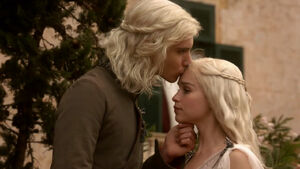
Viserys and Daenerys Targaryen are the product of generations of compound inbreeding, incestuously wedding brother to sister to "keep the bloodlines pure".
Most cultures across Westeros and Essos have rules against incest - sexual contact between direct family members (siblings, parents, or children), though the specific rules can vary. Most major religions in both Westeros and Essos consider marriage between brothers and sisters to be incest.
The dragonlords of the old Valyrian Freehold, however, who once ruled much of Essos, preferred to marry brother to sister "to keep the bloodlines pure". The Doom of Valyria, four hundred years before the War of the Five Kings, wiped out their civilization. One Valyrian noble family, however, survived the Doom with living dragons: House Targaryen, which a hundred years later conquered and unified the Seven Kingdoms, and proceeded to rule them for the next three centuries.
The Targaryens' continued practice of incestuous brother-sister marriages was always a point of contention with the Faith of the Seven, which considered it to be an abomination. This led to outright war between the Faith and the Crown in the generation after the conquest, when Maegor Targaryen brutally fought rebellions by the Faith Militant, quickly earning him the nickname "Maegor the Cruel". Maegor's brutal tactics eventually led to a successful rebellion in favor of his nephew Jaehaerys I Targaryen. While Jaehaerys was married to his own sister, he was a wise diplomat and sought peace with the Faith, successfully negotiating that it didn't have to accept the Targaryens' incestuous marriages but only acknowledge them, the rationale being that the Targaryens' royal status set them above the rules of normal men. This arrangement successfully held for the next two and a half centuries that the Targaryens held power (though they didn't always marry their sisters in every generation). The Targaryens were overthrown because of Robert's Rebellion, not because of societal dislike of royal incest.
There is no indication that any culture in Westeros or Essos has ever condoned sexual relations, much less marriage, between parents and their children - not even the Valyrians. Craster, a wildling living on a very isolated homestead in the wilderness beyond the Wall, would "marry" his own daughters, to father more daughters on them that he would in turn marry (such as Gilly) - but this was only possible due to the extreme isolation they were living in, not condoned as part of a "society". Even the other wildlings utterly despised Craster, and what he was doing was not remotely considered acceptable in wider wildling society.
Marriage between first cousins is not uncommon among the nobility of Westeros, and is not considered incest in their culture. Even Tywin Lannister married his own first cousin, Joanna Lannister. The Valyrians (and later, the Targaryens) preferred to marry cousins of as close a degree as possible if there were no sisters in the current generation of their families. They were also known to have marriages between uncles and nieces (and probably also aunts and nephews): Rhaenyra Targaryen herself married her own uncle, Daemon Targaryen (though uncle-niece marriage is not as close a degree of incest as brother-sister incest).
Polygamy
Bigamy is forbidden in several major religions, such as the Faith of the Seven or the Old Gods of the Forest. The Faith of the Seven considers marrying multiple wives at the same time to be an abomination.
Several other world religions, however, do practice polygamy. The ironborn under the Drowned God religion come close to this with their practice of taking one primary "rock wife" but multiple lower-ranking "salt wives" (basically glorified concubines) - though they never take more than one "rock wife".
The Dornishmen do have a cultural tradition of keeping openly acknowledged mistresses/lovers called "paramours", even when they are already married to someone else. By definition paramours are not "married": unlike the salt wives of the ironborn, the children of paramours are considered bastards without inheritance rights (though unlike the rest of the Seven Kingdoms, bastardy is not considered very shameful in Dorne).
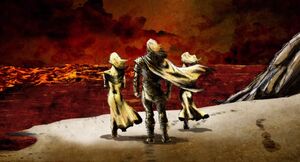
Aegon the Conqueror, following Valyrian customs, was simultaneously married to both of his sister-wives, Visenya and Rhaenys.
The ancient Valyrians were known to practice polygamy - it was not very frequent, but it was not uncommon and unheard of either. Aegon I Targaryen was simultaneously married to both of his sister-wives, Visenya and Rhaenys. Afterwards House Targaryen stopped practicing polygamy, however, realizing that it would greatly antagonize the Faith of the Seven, which was already extremely upset about their incestuous bloodline and marriages (apparently they continued to practice incestuous marriages because fundamentally they already had an incestuous bloodline and nothing could change that, but they could actively choose not to engage in polygamy anymore).
The Dothraki practice polygamy, and a khal can take several wives at once (Khal Drogo just happened to not have any wives already when he wed Daenerys Targaryen). The status of Dothraki marriages can vary considerably, however: some khals will take multiple wives at once, often merely captives taken in raids, who are considered little more than concubines. Yet sometimes, a khal will fall deeply in love with one wife, a khaleesi who practically co-rules by his side, and he won't take any other wives.
Bastardy
- See main article on "Bastardy"
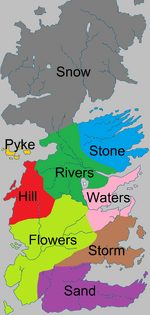
Bastard names by region.
Bastardy - when children are born outside of marriage - is considered so shameful in Westeros that the acknowledged bastard children of the nobility have to use special bastard surnames, one surname for each of the Seven Kingdoms. Bastards from the North use the surname "Snow", such as Jon Snow and Ramsay Snow. Bastards from the desert kingdom Dorne use the surname "Sand", such as Ellaria Sand, as well as Oberyn Martell's daughters (nicknamed "the Sand Snakes" as a result). Dorne has different views on sexuality than the rest of Westeros, and unlike the other kingdoms the Dornish don't consider bastardy to be particularly shameful. Only bastards of the nobility can use these surnames. Bastards are excluded from the line of succession, though on rare occasion a king might grant them Legitimization.
The TV series released a behind-the-scenes video featurette on "Bastards of Westeros" including comments by Martin himself (click this link to view).
Inheritance law
- See main article "Lordship"
There are three major systems of inheritance law practiced in the Seven Kingdoms, all variations on the winner-take-all rule of primogeniture. Most of the Seven Kingdoms follow male-preference primogeniture: sons rank ahead of daughters in the line of succession (i.e. Bran Stark is ahead of his older sister Sansa Stark in the line of succession, and Tyrion was ahead of his older sister Cersei).
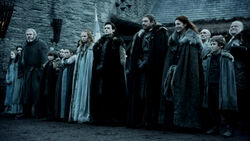
The House Stark line of succession at the beginning of the narrative is: 1 - Robb,
2 - Bran, 3 - Rickon, 4 - Sansa, 5 - Arya. Rickon outranks his older sister Sansa. Jon Snow is a bastard, with no right to inheritance.
Dorne is an exception: due to resisting conquest by the Targaryens and only joining the realm one century ago through marriage-alliance the Dornish were allowed to keep many of their local laws, including gender-blind primogeniture. As a result, in the novels Prince Doran Martell's heir apparent is his daughter Arianne, not her younger brothers (Arianne seems to have been cut from the TV series). Doran himself inherited the rule of Dorne from his mother, who was also a Martell by birth.
- A point of confusion in the novels regarding Dornish inheritance comes from House Yronwood: the eldest child of Lord Anders Yronwood is his daughter Ynys, who is married to Ryon Allyrion - but her younger brother Cletus Yronwood is listed as Lord Anders's heir. The reason for this hasn't been stated - but given that the Yronwoods are staunch "Stony Dornishmen" from the mountains on the western borders of Dorne, descended from the same First Men/Andal mixture as in the neighboring Stormlands and Reach, it is possible that the Yronwoods just customarily follow Andal inheritance law.
Royal inheritance law was heavily modified after the Dance of the Dragons to place female heirs to the throne behind all possible male ones (in the hope that this would prevent another civil war). Under both Andal law and Dornish law, a lord's younger brother only inherits after the lord's entire bloodline is dead (the lord's children and grandchildren) - and thus under Andal and Dornish law, a lord's daughter ranks ahead of the lord's younger brother. Royal inheritance law, in contrast, is the only one of these three systems in which the ruler's daughter ranks behind the ruler's younger brother in the line of succession.
Season 1 of the TV series outright states that if Sansa only has daughters with Joffrey, the Iron Throne would pass to Joffrey's younger brother Tommen, and also that even Robert's second brother Renly is ahead of Myrcella in the line of succession. This is true under royal inheritance law but not for the normal inheritance law, which is followed by Winterfell. Indeed, by Season 5 when all of the legitimate Stark sons are believed dead, Sansa is repeatedly referred to as the legitimate heir to Winterfell. Because the Targaryen exiles considered the Baratheons to be pretenders to the throne, Daenerys was officially the heir of her brother Viserys for many years, simply because all other male Targaryens had in fact died by that point - making Daenerys, upon Viserys's death, the first Targaryen woman to lawfully claim the throne under the modified royal inheritance laws.
Charts of the three inheritance systems:
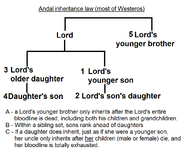
Andal inheritance law (followed in most of Westeros): male-preference primogeniture
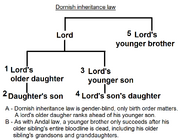
Dornish inheritance law: gender-blind primogeniture
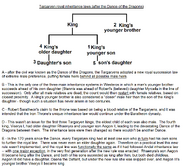
Royal inheritance law, only for the Iron Throne: extreme male-primogeniture, putting female heirs behind all possible male ones
Inheritance law outside of the Seven Kingdoms has not been described in much detail. The Free Folk that live beyond the Wall in Westeros (commonly called "wildlings"), actually don't have any hereditary aristocracy or formal system of inheritance. A clan leader usually isn't followed because he or she is the child of the previous leader, but because all of the clan members respect their strength and skill, and choose to follow that leader. The major example of this is the position of King-Beyond-the-Wall, an over-chieftain that manages to unite all of the wildling clans: the position is not hereditary, and someone only becomes King-Beyond-the-Wall because all of the clans choose to follow him.
Similarly, the Dothraki do not actually have a formal inheritance system, as they follow strength. The infant son of a khal and his wife has no guarantee or "right" to inherit leadership after he dies. Often, if the son of a khal is already a grown man and powerful warrior in his own right, rule over his father's khalasar will pass to him, but only if he has already earned the respect of the other warriors in the khalasar.
Prominent marriages
Wed during the TV series in on-screen ceremonies
- Khal Drogo and Daenerys Targaryen, arranged by Illyrio Mopatis to secure an army for Viserys Targaryen's return to the Seven Kingdoms. Ended with Drogo's incapacitation and mercy killing by Daenerys herself.
- Robb Stark and Talisa Maegyr, secretly married for love, breaking the marriage pact between House Stark and House Frey and ultimately leading to the Red Wedding.
- Tyrion Lannister and Sansa Stark, arranged and forced by Tywin Lannister to provide House Lannister with power over Winterfell and the North through Sansa's claim. Unconsummated.
- Edmure Tully and Roslin Frey, arranged by Robb Stark with Lothar Frey and Black Walder on behalf of Lord Walder Frey to amend the Stark-Frey alliance. Led to the Red Wedding.
- Joffrey Baratheon and Margaery Tyrell, arranged by Petyr Baelish to cement the Lannister-Tyrell alliance. Breaks the bethrothal of Joffrey with Sansa Stark that had been arranged by the late King Robert. Unconsummated because of Joffrey's death at the wedding feast.
- Tommen Baratheon and Margaery Tyrell, arranged by Tywin Lannister and Mace Tyrell to secure the Lannister-Tyrell alliance following the death of King Joffrey.
- Ramsay Bolton and Sansa Stark, arranged by Petyr Baelish and Roose Bolton to cement the hold of House Bolton over the North, where loyalty to House Stark runs deep and ancient. This marriage is considered lawful because Sansa's previous marriage was never consummated - though it can be construed as bigamous and non-binding, given that while Sansa's previous marriage to Tyrion can be annulled, it hasn't been officially annulled yet.
- Rhaegar Targaryen and Lyanna Stark - shown in Bran's flashback vision in the Season 7 finale, revealing that Lyanna was not abducted by Rhaegar but fell in love with him. He was already married to Elia Martell and she was already betrothed to Robert Baratheon, so their marriage was performed in secret - and inadvertently set off Robert's Rebellion.
Wed during the TV series, but off-screen
- {Renly Baratheon} and {Margaery Tyrell}, cementing House Tyrell's support for Renly's claim to the Iron Throne. Went unconsummated before Renly was assassinated.
- {Roose Bolton} and {Walda Frey}; Bolton chose her when Walder Frey offered him any of his grandaughters in marriage; with the bride's weight in silver as dowry. Bolton chose the fattest girl.
- {Petyr Baelish} and the widowed {Lysa Arryn}. The marriage was meant to bring the Vale back under the authority of the Iron Throne, as House Arryn had remained neutral in the War of the Five Kings, and to make Petyr the Lord Protector of the Vale. The marriage lasts only a fortnight, as Petyr murders Lysa.
Wed before the TV series
- {Tywin Lannister} and {Joanna Lannister}, cousins who married out of love.
- {Eddard Stark} and {Catelyn Tully}, bound to marry after Catelyn's first betrothed, Brandon Stark was executed by the Mad King.
- {Jon Arryn} and {Lysa Tully}; along with Eddard and Catelyn's wedding, this marriage sealed the alliance of the houses in rebellion against the Mad King.
- {Robert Baratheon} and Cersei Lannister, this marriage cemented the support of House Lannister to the new King.
- {Stannis Baratheon} and {Selyse Florent}, carried out before Robert's Rebellion. Helped cement the support of House Florent to Stannis' claim to the Iron Throne following the death of Renly.
- Tyrion Lannister and Tysha, a secret wedding carried out by a drunk septon. Forcibly annulled by Lord Tywin, who revealed that Tysha was just a whore, and ordered his guards to gang-rape her, before sending her away.
In the books
Marriage is presented as a cultural universal in the A Song of Ice and Fire novels: every culture across the known world has some version of it. How each culture defines marriage, however, can vary considerably, i.e., some cultures practice polygamous marriages but others do not.
Marriage customs and wedding ceremonies in a few other cultures and religions have been described:
Not much has been said about the wedding ceremony in the religion of the Drowned God. All that has been said is passing mention that marriage ceremonies among the ironborn are officiated by Drowned Men priests - and that marriage ceremonies for "salt wives" are "considerably less solemn" than the ceremony for a lord's primary, "rock" wife. The ironborn apparently don't have "temples" or religious structures, but conduct religious rituals on the shores of the ocean - such as Theon's baptism to reaffirm his faith seen in book/Season 2. It seems probable that weddings among the ironborn are also conducted on the shores of the sea, and possibly involve wading into the water, etc.
In the Lord of Light religion, the wedding ceremony is conducted by a Red Priest (or Red Priestess), and involves the bride and groom jumping over a low bonfire that has been set in a ditch. Symbolically, two separate people begin the jump, two separate souls/flames, but as they pass through the flames their two souls/flames join as one. The only example of such a wedding seen so far in the novels was performed by Melisandre at Castle Black, when one of the wildling leaders, Sigorn son of Styr, marries the Northern noblewoman Alys Karstark, in order to prevent her treacherous great-uncle Arnolf from taking over Karhold. Both the bride and the groom actually followed the Old Gods of the Forest and didn't convert to the Lord of Light religion - the wildlings just don't really have any wedding ceremony rituals, there is no heart tree at Castle Black to conduct a wedding in front of, and Melisandre happened to be there. Apparently they just enjoyed the ceremony of it - or, possibly, they wanted to curry favor with Stannis Baratheon's faction given that Alys was opposed to Bolton rule of the North, and Queen Selyse (who was left at Castle Black in the novels) was in attendance for the wedding. Given that neither the bride or groom were actually followers of the Lord of Light religion in this instance and it was arranged rather quickly (and held during a snowstorm), it isn't clear how representative this example is of a "typical" wedding ceremony in the religion.
In Slaver's Bay weddings are conducted at the city's Temple of the Graces. There are also various customs surrounding a wedding. In Meereen (and presumably the other cities) one of these is that before the wedding, it is expected that the women of the groom's family will inspect the genitals and womb of the bride, to confirm that she is fertile. This is a hallowed and serious custom, also overseen by several of the Graces from the temple (the Blue Graces are known to serve as healers trained in medicine). Men are apparently forbidden to be present. After it is successfully completed, the bride and assembled women eat a special cake which is only made for this event, and which men are forbidden to taste. Another hallowed custom is that the bride symbolically washes the feet of the groom, symbolizing that she will be his handmaiden (it isn't clear if this happens at the actual wedding ceremony or another time). The wedding garments are also fraught with meaning: the bride is dressed in dark red veils above a tokar of white silk, fringed with baby pearls. The pearls symbolize fertility: the more pearls the bride wears, the more healthy children she will bear. These customs are described to Daenerys Targaryen when she is preparing to marry Hizdahr zo Loraq. She refuses to be inspected by the women of Hizdahr's family - in part, secretly, because she fears that the stillbirth of her son Rhaego caused by Mirri Maz Duur also left her womb infertile, and if this is discovered in the ceremony she will lose the political alliance she wanted to secure with the marriage. She also scoffs at symbolically washing Hizdahr's feet, though she agrees to wear the Ghiscari-style wedding dress.
Qarth has its own unique marriage customs, some of which are described to Daenerys when she is contemplating a political marriage-alliance with Xaro Xhoan Daxos. After they are married, a Qartheen husband and wife each retain legal ownership over their previous properties and possessions. However, a custom is that at the wedding, the groom may ask for any of the bride's possessions, and the bride in return can ask for any of the groom's possessions. This request cannot be denied, no matter what it is for, and is seen as a symbol of trust between the two of them. When Daenerys hears of this she realizes that Xaro would use it to lay claim to one of her three dragons, because he knew she wasn't aware of the custom. This sours her on the idea of marrying him and she prepares to leave Qarth. Meeting him a last time, she sarcastically counters that if she did marry him, while she couldn't prevent him from asking for one of her dragons, the equal gift she would ask for in return would be a third of all the ships - not a third of all the ships in Xaro's merchant fleet, or in all of Qarth, but a third of all the ships in the entire world. Xaro scoffs at this and they part ways.
The custom of marriage-by-proxy, which was sometimes practiced in the Medieval Ages, is sometimes practiced among the ironborn. It is unknown if it is acceptable in other regions of Westeros. Euron marries Asha, in her absence and without asking for her consent, to Erik Ironmaker - using a seal to stand in for her at her wedding (probably as a mockery). When Asha hears about that, she comments "I hope Erik did not insist on a consummation". It is unclear if she can have the marriage annulled, either because she has not given her consent; or that using a non-human proxy is invalid; or that the marriage was not consummated; in any case, she hardly gives any thought about her marriage, nor about annulment. Ser Justin Massey, who is interested in wedding Asha, claims that her marriage can be "easily set aside" because it was done by proxy and never been consummated (implying that marriage by proxy is considered invalid by non-ironborn).
In real life
Marriage is a socially recognized union between people that establishes rights and obligations between them and their children. While in a broad sense "marriage" of some kind is a cultural universal found in all human societies throughout history, the exact definitions of "marriage", like conceptions about sexuality as a whole, have varied considerably across different cultures and within the same cultures across time (i.e. some cultures practice polygamous marriages, others do not). Even in Christian Western Europe, strictly speaking, from the fourth to twenty-first centuries there has never been one "traditional" definition of marriage, the definition changed every three or four centuries.
Prior to the year 1000 marriage in Europe was largely a contractual arrangement made by two families to link them together, for political alliance and transfer of property. A son from one family married the daughter from another: ostensibly, the wife would only have procreative sex with her husband and thus marriage confirmed that all of her children were fathered by her husband - which made them "legitimate", confirmed heirs, capable of inheriting his family's property. Men, however, often kept several long-term concubines alongside their wives, who often had official status and certain legal rights. A social/emotional or spiritual union between the husband and wife was not expected, and religious overtones were minimal.
The definition of "marriage", and standards about sexuality in general, in the real-life Middle Ages were drastically changed by the Gregorian Reform movement within the Christian Church after the year 1000. The reformers enforced clerical celibacy (which had not been practiced in the first 1,000 years of Christianity) to lessen the control of political dynasties over powerful Church offices. Thus "marriage" was redefined again to be something the clergy couldn't do. This led to the Church propagating the view that the celibate life was the ideal mode of living, and sex among non-clergy was only permissible within marriage, exclusively for the necessary evil of producing children. Marriage among the non-clergy was redefined as "monogamous, indissoluble...a relationship in which sexual intercourse could give rise to children who could inherit property."[11]
At the same time, the Church reformers started attempting to infuse spiritual values into marriage, redefining it as not simply a social contract but a profound religious/spiritual union. They propagated for the first time the view that marriage was a holy vow that had to be actively consented to by both persons: to be sure, many families still forced their daughters to "consent" to political marriages, but they never would have bothered to pay this token lip-service to the idea of consent during the pre-Christian Roman era.[12]
In Game of Thrones Season 3 episode 6 "The Climb", Edmure Tully complains that he can't be forced to enter into a marriage-alliance with a Frey girl, because a man cannot be forced to take holy vows without his consent - which is a reference to this concept. In the TV version his uncle Brynden simply threatens to punch him if he refuses, but in the book version, Brynden more politely urges that while he's one of the last men who should be giving such a command (given that he refused his own brother Hoster's command to enter into an arranged marriage), Edmure must go through with it because they desperately need to repair their alliance with the Freys. Sansa Stark and Tyrion Lannister are also forced to marry each other against their wills (particularly, Sansa, a captive of the Lannisters), but they still make her go through the token gesture of saying "yes" during the marriage ceremony. Even in the late Middle Ages, marriages were rarely made for love, but to secure political alliances and rights to property:
- "Marriage in the Middle Ages was not an affirmation and official recognition of love between two people as much as it was the establishment of a legal unit which legitimized children and facilitated the transfer of property from one family to another and one generation to another."[13]
The Gregorian Reforms of the eleventh century not only resulted in a celibate priesthood, but succeeded in making a politically stronger clergy not dominated by the nobility, who could in time pressure the aristocracy to accept their moral dictates. The Catholic Church began to redefine marriage by placing limits on incestuous marriage between cousins of a certain degree (see the main article on "Incest"). Where once a man could marry his first cousin, he now could not marry his third cousin or any closer relation. It is theorized that the Church put limits on incestuous marriages within certain degrees because it often led to civil wars within families, as it left the succession order muddled.[14]
Attitudes about marriage changed somewhat after the Black Death devastated Europe starting in 1346, which killed over a third of the population. For the first time there was a massive labor shortage, with not enough peasants to work the fields and feed the towns and cities. While the Church used to espouse that marriage was distant second to choosing a life of celibacy, after the plague Church sermons began praising and valorizing marriage as also a worthy state of living, to encourage the commoners to produce more children.[15] Westeros's analogue of the Black Death was the Great Spring Sickness, a major plague that broke out about 90 years before the events of the main novels: the plague strikes right after the first of the Tales of Dunk and Egg prequel novellas, and thus the bulk of their stories take place in the plague's aftermath. The massive depopulation caused by the plague may have had a similar effect on attitudes about marriage in Westeros.
See also
References
- ↑ "Politics of Marriage" video featurette
- ↑ "Eastwatch"
- ↑ [1]
- ↑ "What Is Dead May Never Die" - Myrcella: "Mother says I'll have a new gown for the ceremony...But yours will be ivory, since you're the bride."
- ↑ Bryan Cogman Q&A
- ↑ "Unbowed, Unbent, Unbroken"
- ↑ The Free Folk
- ↑ "Winter Is Coming"
- ↑ "A Golden Crown"
- ↑ "The Spoils of War"
- ↑ Ruth Mazo Karras, Sexuality in Medieval Europe: Doing Unto Others (Routledge, 2005, 2d ed. 2012), 156.
- ↑ Karras 70.
- ↑ Karras 147
- ↑ Karras 68
- ↑ Karras 68
Game of Thrones Tying the Knot Ceremony
Source: https://gameofthrones.fandom.com/wiki/Marriage